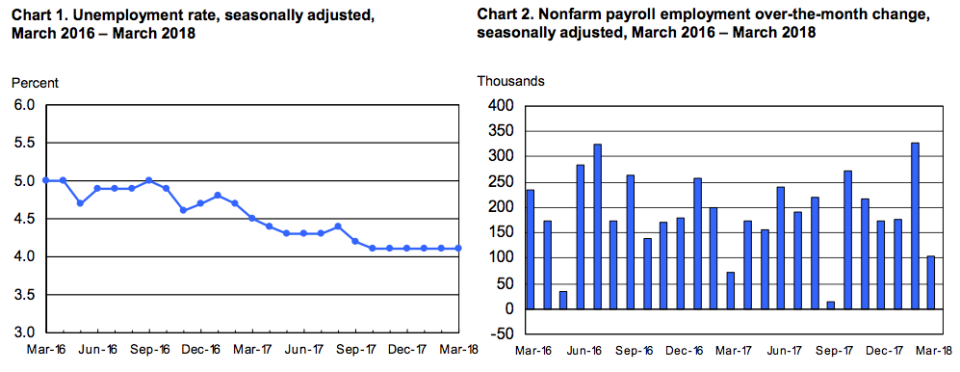Job growth slows to a six-month low in March
The March jobs report is out and it’s a miss.
In March, the economy added 103,000 jobs while the unemployment rate held steady at 4.1% for the sixth-straight month, according to the latest data from the Bureau of Labor Statistics.
Economists had expected the report to show 185,000 jobs were created in March while the unemployment rate was expected to fall to 4%, according to estimates from Bloomberg. March’s report is also a big slowdown from February and represented the fewest jobs created in six months.
Friday’s report also showed that job growth in January was revised down slightly, to job gains of 176,000 from 239,000 to start the year, while February’s data were revised slightly higher as 326,000 jobs are now estimated to have been created in the year’s second month.
After Friday’s numbers average jobs gains over the last three months now stand at 202,000.
Jed Kolko, chief economist at Indeed, said Friday that while March’s total job gains are fewer than expected and on the surface appear to be a disappointment, this level of job growth is “more than enough to keep up with the slow-growing working-age population.”
“Eventually, we’ll have to get used to monthly [job] gains of ~100,000 or less,” Kolko added.

Wage data came in in-line with expectations, however, as average hourly earnings rose 0.3% over the prior month and 2.7% over the prior year. Economists expected average hourly earnings to rise 0.3% over the prior month and 2.7% over the prior year. Both figures were an improvement from February.
“This jobs report should not change anyone’s views on the outlook for monetary policy,” said Neil Dutta, an economist at Renaissance Macro, following the report.
“The principle story as we see it is that despite above trend jobs growth in the main, the unemployment rate has been flat for six months.”
Ahead of the report, U.S. stock futures were lower after news late Thursday that President Donald Trump has told administration officials to consider an additional $100 billion in tariffs on Chinese imports. Following the report stock futures remained lower, with Dow futures off about 225 points, S&P 500 futures down about 22, about Nasdaq futures off 66.
Treasury yields were staging a slight rally, with the 10-year yield hovering near 2.8% and the 2-year yield sitting near 2.28%.
While the official unemployment rate held steady for a sixth-straight month in March, the underemployment rate, which captures those out of work and those who want full-time work but are working part-time, moved down to 8% in March after having hit 8.2% the prior month. Additionally, weekly hours worked, which some economists had expected to decline on account of poor weather in March, held steady at 34.5.
By industry, the largest gains were seen in education and health services as well as professional and business services, the two areas that are most often leaders in terms of monthly job gains.
Construction employment was the biggest loser in March, declining by 15,000 after a strong 65,000 jobs were added to the sector in February.
Paul Ashworth, chief U.S. economist at Capital Economics, said Friday’s report, “is a good illustration of the inherent volatility in the non-farm payroll data.”
Ashworth added that while March’s job gains were weaker than expected, “there is still evidence of an acceleration in the underlying pace of employment growth… looking through the volatility, employment growth is trending higher and wage growth is starting to heat up.”
—
Myles Udland is a writer at Yahoo Finance. Follow him on Twitter @MylesUdland
Read more from Myles here:


